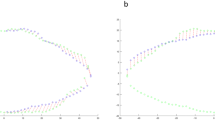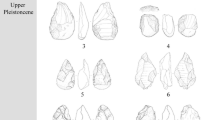Abstract
If different parts of curated stone tools were resharpened to different degrees, then allometric patterns reside in tools’ variation. Allometry and the related reduction thesis have important typological and theoretical implications that warrant their study. To seek allometric pattern in Folsom replicas, this study uses conventional orthogonal dimensions but also the inter-landmark distances by which Buchanan (Journal of Archaeological Science, 33, 185–199, 2006), applying the Huxley-Jolicoeur approach, found allometry in archaeological Folsom points. Like Buchanan’s, it computes bivariate and multivariate allometric coefficients for several variable sets to test models of Folsom-point resharpening. In bivariate analysis, plan area as gross-size measure yields results consistent with the Huxley-Jolicoeur approach; gross-size measures mass, centroid size, and total length do not scale as expected. Multivariate results are robust to gross-size measure. Length variables are positively, width variables and thickness negatively, allometric. Using different variables, results corroborate the allometric variation found in earlier studies. Distributions derived from multifactorial synthesis of multivariate and other reduction measures demonstrate the value of this approach by linking stone-tool allometry to behavioral-ecology models of broad scope. Allometric analysis requires careful variable selection and rewards approaches that separately characterize those constituent parts of the whole objects that are points.







Similar content being viewed by others
References
Ahler, S., & Geib, P. R. (2000). Why flute? Folsom point design and adaptation. Journal of Archaeological Science, 27, 799–820.
Binford, L. R. (1973). Interassemblage variability: The Mousterian and the ‘functional’ argument. In C. Renfrew (Ed.), The explanation of culture change: Models in prehistory (pp. 227–254). London: Duckworth.
Buchanan, B. (2006). Analysis of Folsom projectile point resharpening using quantitative comparisons of form and allometry. Journal of Archaeological Science, 33, 185–199.
Charlin, J., & Cardillo, M. (2018). Reduction constraints and shape convergence along tool ontogenetic trajectories: An example from Late Holocene projectile points of southern Patagonia. In B. Buchanan, M. Eren, & M. O’Brien (Eds.), Convergent evolution and stone-tool technology (pp. 109–129). London: MIT Press.
Charlin, J., & González-José, R. (2018). Testing an ethnographic analogy through geometric morphometrics: A comparison between ethnographic arrows and archaeological projectile points from Late Holocene Fuego-Patagonia. Journal of Anthropological Archaeology, 51, 159–172.
Dibble, H., Holdaway, S. J., Lin, S. C., Braun, D. R., Douglass, M. J., Iovita, R., McPherron, S., Olszewski, D. I., & Sandgathe, D. (2017). Major fallacies surrounding stone artifacts and assemblages. Journal of Archaeological Method and Theory, 24, 813–851. https://doi.org/10.1007/s10816-016-9297-8.
Hammer, Ø. (2019) Past: Paleontological statistics (v. 3.25) Reference Manual. https://folk.uio.no/ohammer/past/past3manual.pdf
Hammer, Ø., & Harper, D. A. (2006). Palaeontological data analysis. Oxford: Blackwell.
Hammer, Ø., Harper, D. A., & Ryan, P. D. (2001). Past: Paleontological statistics software package for education and data analysis. Palaeontologia Electronica, 4(1) http://palaeo-electronica.org/2001.
Hoffman, C. M. (1985). Projectile point maintenance and typology: Assessment with factor analysis and canonical correlation. In C. Carr (Ed.), Concordance in archaeological analysis: Bridging data structure, quantitative technique, and theory (pp. 566–611). Kansas City: Westport.
Hunzicker, D. A. (2005). Folsom hafting technology: An experimental archaeological investigation into the design, effectiveness, efficiency and interpretation of prehistoric weaponry. MA thesis, Dept. of Museum and Field Studies, Univ. of Colorado, Boulder, CO, USA.
Hunzicker, D. A. (2008). Folsom projectile technology: An experiment in design, effectiveness, and efficiency. Plains Anthropologist, 53, 291–311.
Iovita, R. (2010). Comparing stone tool resharpening trajectories with the aid of elliptical Fourier methods. In S. Lycett & P. Chauhan (Eds.), New perspectives on old stones: Analytical approaches to Paleolithic technologies (pp. 235–253). New York: Springer.
Iovita, R. (2011). Shape variation in Aterian tanged tools and the origins of projectile technology: A morphometric perspective on stone tool function. PLoS One, 6(12), e29029.
Kaňáková, L., Šmerda, J., & Nosek, V. (2016). Analýza Kamenných Projektilů z Pohřebiště Starší doby Bronzové Hroznová Lhota. Traseologie a Balistika (Analysis of lithic arrowheads from the early bronze age cemetery at Hroznová Lhota: Use-wear and ballistic analysis). Archeologicke Rozhledy, 68, 163–201.
Klingenberg, C. P. (2007). Multivariate allometry. In M. Corti, A. Loy, G. Naylor, & D. Slice (Eds.), Advances in morphometrics (pp. 23–49). New York: Plenum.
Klingenberg, C. P. (2016). Size, shape and form: Concepts of allometry in geometric morphometrics. Developmental Genes and Evolution, 226, 113–117.
Kuhn, S. L., & Miller, D. S. (2015). Artifacts as patches: The marginal value theorem and stone tool life histories. In N. Goodale & W. Andrefsky (Eds.), Lithic technological systems and evolutionary theory (pp. 173–197). Cambridge: Cambridge.
Lin, S. C. (2017). Flake selection and scraper retouch probability: An alternative model for exploring middle Paleolithic assemblage retouch variability. Archaeological and Anthropological Sciences, 10(7), 1791–1806. https://doi.org/10.1007/s12520-017-0496-3.
Miller, D. S. (2018). From colonization to domestication: Population, environment, and the origins of agriculture in eastern North America. Salt Lake City: University of Utah Press.
Prentiss, A., Walsh, M., Skelton, R., & Markes, M. (2017). Mosaic evolution in cultural frameworks: Skateboard decks and projectile points. In L. Mendoza Straffen (Ed.), Cultural phylogenetics: Concepts and applications (pp. 113–130). Basel: Springer.
Presnyakova, D., Braun, D. R., Conard, N. J., Feibel, C., Harris, J., Pop, C. M., Schlager, S., & Archer, W. (2018). Site fragmentation, hominin mobility and LCT variability reflected in the early Acheulean record of the Okote member, at Koobi Fora, Kenya. Journal of Human Evolution, 125, 159–180.
Shea, B. T. (1985). Bivariate and multivariate growth allometry: Statistical and biological considerations. Journal of Zoology, 206, 367–390.
Shott, M. J. (1996). An exegesis of the curation concept. Journal of Anthropological Research, 52, 259–280.
Shott, M. J., & Otárola-Castillo, E. (2018). Parts and wholes: Geometric morphometric reduction allometry and modularity in experimental Folsom points. Poster presented at the 83rd Annual Meeting of the Society for American Archaeology. Washington, D.C., 12 April.
Shott, M. J., & Seeman, M. F. (2017). Use and multifactorial reconciliation of uniface reduction measures: A pilot study at the Nobles Pond Paleoindian site. American Antiquity, 82, 723–741.
Shott, M. J., & Trail, B. (2010). Exploring new approaches to lithic analysis: Laser scanning and geometric morphometrics. Lithic Technology, 35, 195–220.
Shott, M. J. (2005). The reduction thesis and its discontents: Review of Australian approaches. In C. Clarkson & L. Lamb (Eds.), Lithics ‘DownUnder’: Australian perspectives on lithic reduction, use and classification (pp. 109–125. British Archaeological Reports International Monograph Series 1408). Oxford: Archaeopress.
Shott, M. J., Hunzicker, D. A., & Patten, B. (2007). Patterns and allometric measurement of reduction in experimental Folsom bifaces. Lithic Technology, 32, 203–217.
Shott, M. J. (2010). Size-dependence in Assemblage Measures: Essentialism, Materialism, and 'SHE' Analysis in Archaeology. American Antiquity, 75, 886–906.
Shott, M. J. (2016). Survivorship distributions in experimental spear points: Implications for tool design and assemblage formation. In R. Iovita & K. Sano (Eds.), Multidisciplinary approaches to the study of Stone Age weaponry (pp. 245–258). Vertebrate Paleobiology and Paleoanthropology Series). Dordrecht: Springer.
Shott, M. J. (2020). Toward a Theory of the Point. In H. Groucutt (Ed.), Culture History and Convergent Evolution: Can We Detect Populations in Prehistory? Paleobiology and Paleoanthropology Series. Cham: Springer.
Stafford, C. R., & Cantin, M. (2009). Early Archaic Occupations at the James Farnsley Site, Caesars Archaeological Project, Harrison County, Indiana. Terre Haute: Indiana State University Archaeology & Quaternary Research Laboratory Technical Report 39.
Suárez, R., & Cardillo, M. (2019). Life history or stylistic variation? A geometric morphometric method for evaluation of fishtail point variability. Journal of Archaeological Science: Reports, 27. https://doi.org/10.1016/j.jasrep.2019.101997.
Surovell, T. A. (2009). Toward a behavioral ecology of lithic technology: Cases from Paleoindian archaeology. Tucson: University of Arizona Press.
Acknowledgments
David Hunzicker graciously made available his data and provided resin casts of original and resharpened replicas. Brian Trail measured inter-landmark distances on Folsom replicas. D. Shane Miller and the University of Utah Press granted permission to use Fig. 1. Three anonymous reviewers made helpful comments that improved the ms., and Margaret Beck and Valentine Roux guided it through the editorial process. I am responsible for any errors or omissions.
Author information
Authors and Affiliations
Corresponding author
Ethics declarations
Conflict of Interest
I declare no conflicts of interest.
Additional information
Publisher’s Note
Springer Nature remains neutral with regard to jurisdictional claims in published maps and institutional affiliations.
Rights and permissions
About this article
Cite this article
Shott, M.J. Allometry and Resharpening in Experimental Folsom-Point Replicas: Analysis Using Inter-Landmark Distances. J Archaeol Method Theory 27, 360–380 (2020). https://doi.org/10.1007/s10816-019-09437-7
Published:
Issue Date:
DOI: https://doi.org/10.1007/s10816-019-09437-7




